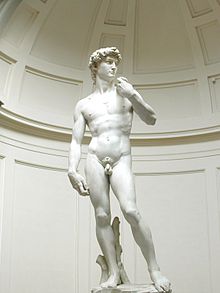Masterpiece: Difference between revisions
Tassedethe (talk | contribs) |
WebCiteBOT (talk | contribs) BOT adding link to WebCite archive of now defunct Encarta link(s) |
||
| Line 8: | Line 8: | ||
The [[Royal Academy]] in [[London]] is one institution that has acquired a fine collection of "Diploma works" as a condition of acceptance. |
The [[Royal Academy]] in [[London]] is one institution that has acquired a fine collection of "Diploma works" as a condition of acceptance. |
||
It probably derives from the Dutch "meesterstuk" (German: Meisterstück), and the form "masterstik" is recorded in English in 1579 (or in [[Scots language|Scots]], since this was from some [[Aberdeen]] guild regulations), whereas "masterpiece" is first found in 1605, already outside a guild context, in a [[Ben Jonson]] play<ref> [[OED]]:"Masterpiece". See also: [http://encarta.msn.com/dictionary_1861628683/masterpiece.html Encarta]</ref>. |
It probably derives from the Dutch "meesterstuk" (German: Meisterstück), and the form "masterstik" is recorded in English in 1579 (or in [[Scots language|Scots]], since this was from some [[Aberdeen]] guild regulations), whereas "masterpiece" is first found in 1605, already outside a guild context, in a [[Ben Jonson]] play<ref> [[OED]]:"Masterpiece". See also: [http://encarta.msn.com/dictionary_1861628683/masterpiece.html Encarta]. [http://www.webcitation.org/5kx5TnWWs Archived] 2009-11-01.</ref>. |
||
Nowadays it is used for an exceptionally good piece of creative work<ref>[http://www.guardian.co.uk/world/2008/jan/23/russia.art 'One damn masterpiece after another' Adrian Searle, The Guardian, Wednesday January 23 2008]</ref> or the best piece of work of a particular artist or craftsman<ref> |
Nowadays it is used for an exceptionally good piece of creative work<ref>[http://www.guardian.co.uk/world/2008/jan/23/russia.art 'One damn masterpiece after another' Adrian Searle, The Guardian, Wednesday January 23 2008]</ref> or the best piece of work of a particular artist or craftsman<ref>{{cite web|title=Encarta|url=http://encarta.msn.com/dictionary_1861628683/masterpiece.html|work=|archiveurl=http://www.webcitation.org/5kx5TnWWs|archivedate=2009-11-01|deadurl=yes}}</ref>. |
||
Examples include: [[Leonardo Da Vinci]]'s ''[[Mona Lisa]]'', [[Michelangelo]]'s ''[[David (Michelangelo)|David]]'', [[Ludwig van Beethoven]]'s ''[[Symphony_No._9_(Beethoven)|Ninth Symphony]]'', [[Leo Tolstoy]]'s ''[[War and Peace]]'' and [[Johann_Wolfgang_von_Goethe|Goethe]]'s ''[[Goethe's Faust|Faust]]''. |
Examples include: [[Leonardo Da Vinci]]'s ''[[Mona Lisa]]'', [[Michelangelo]]'s ''[[David (Michelangelo)|David]]'', [[Ludwig van Beethoven]]'s ''[[Symphony_No._9_(Beethoven)|Ninth Symphony]]'', [[Leo Tolstoy]]'s ''[[War and Peace]]'' and [[Johann_Wolfgang_von_Goethe|Goethe]]'s ''[[Goethe's Faust|Faust]]''. |
||
Revision as of 05:09, 22 November 2009


This article or section is in a state of significant expansion or restructuring. You are welcome to assist in its construction by editing it as well. If this article or section has not been edited in several days, please remove this template. If you are the editor who added this template and you are actively editing, please be sure to replace this template with {{in use}} during the active editing session. Click on the link for template parameters to use.
This article was last edited by WebCiteBOT (talk | contribs) 14 years ago. (Update timer) |
Masterpiece (or chef d'œuvre) in modern usage refers to a creation that has been given much critical praise, especially one that is considered the greatest work of a person's career or to a work of outstanding creativity, skill or workmanship.
Originally, the term masterpiece referred to a piece of work produced by an apprentice or journeyman aspiring to become a master craftsman in the old European guild system. His fitness to qualify for guild membership was judged partially by the Masterpiece, and if he was successful, it was retained by the guild. Great care was therefore taken to produce a fine piece in whatever the craft was, whether confectionery, painting, goldsmithing, knifemaking, or many other trades. The Royal Academy in London is one institution that has acquired a fine collection of "Diploma works" as a condition of acceptance.
It probably derives from the Dutch "meesterstuk" (German: Meisterstück), and the form "masterstik" is recorded in English in 1579 (or in Scots, since this was from some Aberdeen guild regulations), whereas "masterpiece" is first found in 1605, already outside a guild context, in a Ben Jonson play[1].
Nowadays it is used for an exceptionally good piece of creative work[2] or the best piece of work of a particular artist or craftsman[3].
Examples include: Leonardo Da Vinci's Mona Lisa, Michelangelo's David, Ludwig van Beethoven's Ninth Symphony, Leo Tolstoy's War and Peace and Goethe's Faust.
See also
- Magnum opus
- Painting the Century 101 Portrait Masterpieces 1900-2000
- The Virtual Collection of Masterpieces
